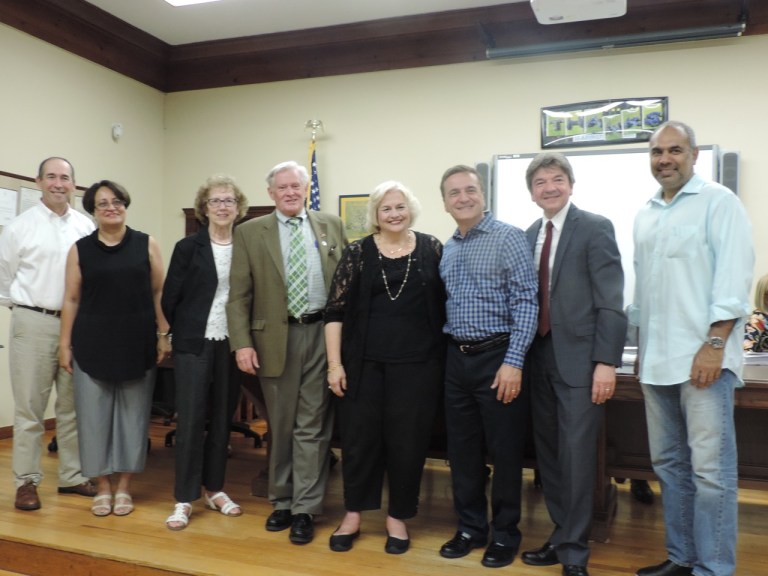
By Samuel Glasser
There was a bittersweet air to the Herricks school board’s last meeting of the school year Thursday night — the board heard the generally favorable results while saying farewell to the board’s vice president, Christine Turner, who is stepping down after 27 years.
Turner served with 22 board members and four superintendents during her tenure. Town officials and numerous former board members who served alongside Turner were on hand to honor her.
“We will miss you dearly,” district Superintendent Fino Celano said.
From a superintendent’s perspective, Celano said, Turner’s tenure was “a model of board-superintendent relations and teamwork.”
The enrollment and demographic study, the first commissioned by the district in more than a decade, forecasts that enrollment will hold steady through 2021 after steep declines in recent years.
Barbara Graziano, a planning manager with the Office of School Planning and Research for Western Suffolk BOCES, presented the findings.
They shows that Herricks’ enrollment dropped 5.4 percent, or 222 students, in the 10 years from 2006 to 2016, and the decline was steep until 2012. Enrollment rebounded the following year and then stabilized.
The outlook from 2016 to 2021 is that enrollment will increase by 21 students, or 0.5 percent, Graziano said.
Enrollment across Nassau County fell 3.7 percent from 2006 to 2016. It is expected to roughly stabilize, falling 0.1 percent by 2021.
The path to enrollment stability, however, is not a straight line from kindergarten to high school. The number of graduating seniors has outpaced the number of incoming kindergarteners for years, a trend that is expected to continue.
For instance, the 2016-2017 school year saw 244 students enter kindergarten, while 326 are expected to graduate high school this month, a difference of 82 students. For 2017-2018, the deficit is projected to be 142 students.
Offsetting the trend, however, is the fact that the district’s “migration ratios are positive,” Graziano said.
“People with children moving into the district will offset the declining birthrate” and kindergarten enrollment,” she said.
Enrollment in grades six, seven and eight for the 2016-2021 timeframe is expected to show a gain of 52 students, offsetting the projected losses in the elementary and high school schools, for the net gain of 21 students, the study shows. That same group lost 82 students from 2006 to 2016.
The study showed that Long Island’s birth rate has been on a long downward slope for nearly 20 years. The trend accelerated after 2005, but stabilized in 2013 and then began increasing.
The district’s birthrate for 2003 to 2015 peaked in 2004, the study shows. It has been fluctuating but is also on a downward trajectory.
Graziano said that with a projected stable school population, Herricks is not expected to experience a lack of space nor a surplus of classrooms in the coming years. The district is currently in the midst of several capital improvement projects.
The study also illustrated the long-term ethnic shift in both school enrollment and the population at large.
From 2000 to 2015, the ethnic makeup of the student body shifted from mainly white to Asian. In round numbers, white enrollment declined from 57 percent to 33 percent, while the proportion of Asian students grew from 37 percent to 59 percent.
Hispanic enrollment grew by one percentage point to a 6 percent share. African-American enrollment grew from 0.3 to 0.6 percent.
The change in students’ ethnicity paralleled that of the general population of the district for the same period, the study shows.
The white population declined from 72 percent to 53 percent, while the Asian population grew from 22 to 38 percent. The Hispanic population grew from 4 to 7 percent, and African-American residents were steady at 0.5 percent.
The trend in Herricks parallels that over the last decade with greater ethnic diversity seen in North Shore schools. The Great Neck, Manhasset, Roslyn, Port Washington, Herricks, Mineola, Sewanhaka, East Williston and New Hyde Park-Garden City Park school districts have all seen populations of non-white students increase from the 2005-06 school year to the 2014-15 school year, state Education Department data shows.
This is the first demographic study for Herricks in more than 10 years.
In response to a question regarding the frequency of this study, Graziano said, “Since you seem to be stable, I suggest every two or three years.”
In honoring Turner, North Hempstead Town Supervisor Judi Bosworth, Town Councilman Peter Zuckerman (D-East Hills) and Town Clerk Wayne Wink presented Turner with the town’s proclamation of “a day of special recognition” marking her retirement from the board.
Current and former board members who worked with Turner — including Bosworth who previously served on the Great Neck board of education — praised her for her mentoring and advice over the years.
“It’s been an honor and a privilege to serve the community,” Turner said. “I’m looking forward to having the extra time. This is like having a second full-time job.”






